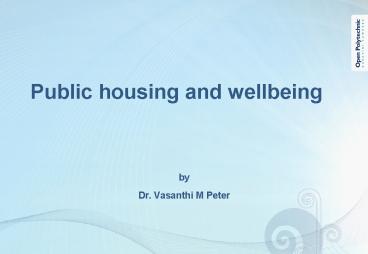Public housing and wellbeing PowerPoint PPT Presentation
1 / 19
Title: Public housing and wellbeing
1
Public housing and wellbeing
- by
- Dr. Vasanthi M Peter
2
Paper plan
- The current housing environment and adverse
effects on poorer communities in New Zealand -
Introduction - Internal and external factors such as
political/legal, economic, social, technological
and environmental variables (PESTEL analysis)
considered for the study Review of Strategic
Management Literature Section - Results of the study shows some average
performance of selected environmental, and
technological variables Finding - The role of government in promoting housing
stability for the marginalised group is explored
- Discussion Section
3
Importance of this research
- The research adds value to current policy
discussions on housing affordability - The continuing threat of the real estate bear
market in NZ (including fall of some of the Euro
governments, Greece) results in wellbeing and
affordability issues.
4
New Zealand Public Housing
- The current rising unemployment, global
uncertainties and complexities, calls for
wellbeing measures to be taken seriously within
government housing departments. - Though the main intention of New Zealand housing
strategy aimed for the period 2006-2015 is to
provide access to quality, affordable homes for
all New Zealanders is relevant at all times, yet
there are few adaptations that are necessary
during economic disturbances of 2011 and beyond.
5
Wellbeing and Systems thinking
- PESTEL Analysis
- Political, Economical, Social, Technological,
Ecological and Legal factors - Theoretical framework for the study is based on
PESTEL analysis - It is evident that little systematic research has
been applied for housing sector following PESTEL
analysis in the strategic management context.
6
Political and Legal Factors Research Questions
- Is state/public housing instituted (for example,
NZ Welcome Home loan) loan to value ratio an
important variable in the determinant of credit
risk? - Is it the credit-constrained households in the
population, including low-income households
default on their payments?
7
Economic Factors Research Question
- What is the role of changing prices, expressed
through affordability indicator?
8
Social Factors Research Questions
- Do employment status, educational level, have
any bearing on credit risk? - Do social variables such as marital status,
number of dependents, younger families, family
type affect the risk of default?
9
Technological factor Research question
- Does public housing technology including
assistance systems affect default risk?
10
Environmental factor Research question
- Finally, does environmental factors including
locational factor influence default risk?
11
Research method
- Both Qualitative and Quantitative research
methods are used for building the risk management
model - The model is used to measure the resourcefulness
of individual clients or the interventions of
financial counsellors
12
Data
- This study provides an extensive examination of
data using secondary government housing data.
Data from Housing New Zealand, Statistics NZ
files are used. - The model assists in identifying the extent
factors, such as political economical, social and
others influence the risk of default in home
ownership.
13
Welcome Home Loan and Home Ownership
- Education programmes
- The Corporations Welcome Home Loan and Home
Ownership. - The Welcome Home Loan measure was to assist
9251,130 in 2008 households through lending. - This measure was not achieved, with only 716
households assisted in 2008.
14
Hobsonville project
- Developed around 3,000 homes
- Fifteen percent for state housing
- 15 percent affordable homes for first-home buyers
- Others (60 percent) of the homes for private
owners - Encourage closer lender-recipient relationships
for affordable housing.
15
HNZC strategy 2007-2012
- State housing, implementation of the Te Au Roa,
the Ma- ori Strategic Plan - Improved Home Ownership Education programme
- Support new housing solutions for the Ma- ori
in rural areas - The Ma- ori in rural areas measure was to
approve 2530 rural loans. - This measure was achieved, with the approval of
26 loans.
16
Eastern Porirua and Auckland HNZC clients
- Eastern Porirua
- In Auckland the need for home prices should
become affordable for low to middle income
clients - Observation by program staff and external
counsellors - to help the cases succeed in home
ownership endeavours - The preliminary finding suggested that the
homeownership programs have not been highly
successful in assisting all the prospective
clients into homeownership.
17
Findings
- Preliminary test results show that the risk
management model for Housing NZ are robust. - Results Good performance of human resource
related variable such as human capital resulted
in opportunities - Poor performance of economy, low income
households resulted in distress. - The study demonstrates environment (including
housing location) and its dynamics play a crucial
role in Housing New Zealands organisational
performance and its final impact on its clients.
18
Recommendations Homeownership and safety net
- To assist middle/low income households who have a
desire and ability to purchase a home government
initiatives - Introduce the program safety net
- Data management systems Safety Net
- Endeavour to develop data management systems that
are more flexible - Ensure close monitoring of servicing agents.
19
Any questions

